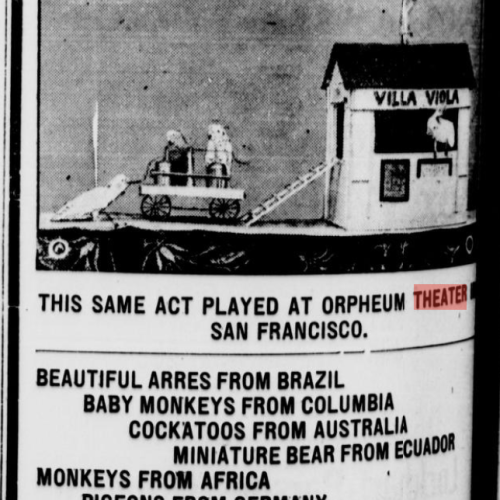The Royal theater was found on 351 N. Front St. Coos Bay, Oregon, formally known as ‘The Dime’. This theater operated for about 5 years from 1909 to 1914 where it was eventually closed. It has approximately 500-600 seats, including a small balcony. On November 2nd, 1909, the Royal had its grand opening at 7:15pm where they showed the Selig film of 1000 feet, The Cowboy Millionaire, which was released on October 21st of that year; the admission price was 10 cents1.
The Royal had undergone numerous changes in ownership and management throughout its operation. It originally was opened by the mainly Robert Marsden and others; they acted as both owners and managers until G. J. Lemanski bought the Royal from Marsden on August 12th, 19112. Lemanski acted as the main proprietor and manager of the Royal, until he appointed other managers as he owned multiple properties in Coos Bay and in North Bend. Mr. Tope was appointed by Lemanski after the former manager E. N. Fairchild on December 27th, 19123. And then finally the last manager I had found before the Royal closed was A. C. Germond, who began management on March 5th, 19134. In the Winter of 1914, Lemanski had advertised for a new theater he was opening on December 1st, the Noble Theater on Central Avenue. As a result of the new theater, Lemanski decided to close the Royal theater; he left the venue with the fixtures and chairs for special occasions but took out all the machines to most likely move them to his new theater5.
This theater also set itself apart from other competitors by not only the events and films they exhibited, but also by hits physicality. The original owner, Marsden and others, had hired local artist Mr. McLaren to create one of the most realistic pieces that is personal to the Coos Bay community, the curtains which depicted a Coos Bay bar scene; a tug is passing out with a schooner in tow. McLaren also painted other pieces for this theater to create a unique, unforgettable experience for the audience6.
The Royal Theater had a wide range of films that would be exhibited; they showed western dramas like The Golden Ladder, comedies like Man with Three Wives, to even pictures that are interpretations of poems by Whittier10. But to set itself further apart from competition, the theater was also a venue for various entertainments of different means. Because how many theaters can say they had the chance to hold an act by Miss Viola’s circus? In 1913, the Royal held an event for the act, which included animals from various environments around the world; they had Arres from Brazil, monkeys from Columbia, parrots from tropical lands, and so much more. Their star of the show was “Lolotte, the Man Monkey with human intelligence,”7. He supposedly had the ability to do everything a human could do besides the obvious of speech. The rarity of having such an incredible act, let alone a circus act, is almost not worth considering. So when having such an abnormal opportunity present itself, it would be moronic not to drive the ticket prices up. Normally ticket prices ranged from 10 cents to 15 (depending on if you get balcony seating), but in this circumstance of the abnormal act, admission was 25 cents for lower floor; 15 cents for balcony; and 10 cents for children. 25 cents in 1913 to today’s current dollar value is about $7.38; imagine being able to go see a circus act for a mere $7.50!7
Besides the film dramas, what is a theater without a little scandal? The Royal in February 04th of 1914, front page news as they had a fire mishap in the kitchen; one of the stove-pipes and chimney had apparently not been fire proof, and when the board wall alongside the chimney caught and carried the flames into the garret of the building. The defective items had not been approved by the building inspector, to which he said they made the change the day prior and was not passed on by him8. That’s not even the worst incident; on March 30th, 1911, The Royal made front page news once again due to Mrs. Francis Hatton, a performer, being struck by a swinging curtain weight. Hatton was in the act when she was struck and she had sustained very serious injuries. In the attached article titled, Badly Hurt at Royal Theater, Mrs. Hatton apparently wasn’t the first person to get struck; this was the third or fourth incident due to a lack of negligence by the managers in not fixing the curtain weight9. It makes sense why the Royal Theater underwent numerous changes in management throughout the short timespan it was open. And probably the reason why G. J. Lemanski ultimately decided to let this theater finally rest after 5 years, where he saw his luck in just starting completely over and opening the Noble Theater.







